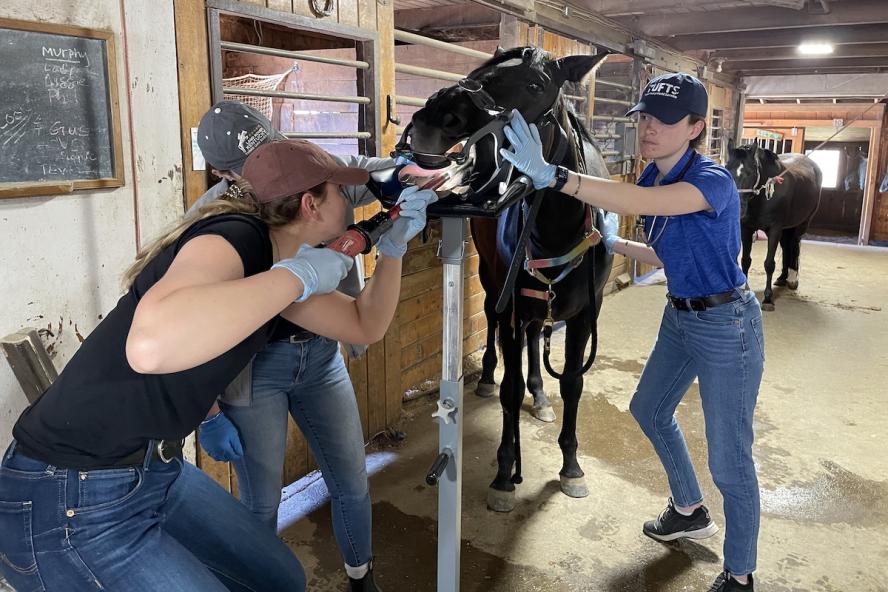-
About
- Leadership & Faculty
- News & Events
-
Academics
- Graduate
- Advanced Clinical Training
- Continuing Education
- Academic Offices
-
Student Life
-
Research
-
Hospitals & Clinics
- Emergency Care
- Hospital Services
-
Community Outreach
- Volunteer
Ensuring Smiles in the Stalls
Large animal dentistry lab increases hands-on learning via innovative method

Routine dental care for horses is essential to their health, according to the American Association of Equine Practitioners, as periodic examinations and regular maintenance can help horses to be more comfortable, use feed more efficiently, enhance performance, and extend their life.
At Cummings School of Veterinary Medicine, Julia Wilkinson, V10 (she/her), interim chair of and assistant clinical professor in the Department of Ambulatory Medicine and Theriogenology (DAMT), teaches equine dentistry to D.V.M.-candidates through the use of horse teeth models, created on campus, which enable more effective hands-on instruction.
Making improvements to equine dentistry instruction
For several years, an observationally based equine dentistry lab has been offered during a Clinical Skills course, according to Wilkinson. “It was difficult to make it hands-on with only a handful of teaching horses,” she says.
In 2022, the DAMT received a generous gift, creating the Roadie Fund for Excellence in Equine Dentistry. The fund enabled the purchase of equine dental training equipment. Named in honor of the donor’s beloved horse, the Roadie Fund also created an endowment to help sustain an advanced equine dentistry rotation for students entering either equine or multi-species practice.
Last year, Wilkinson began offering a new equine dental elective during students’ clinical years. With the new lab and elective, equine dentistry instruction has been improved from first year through graduation. “First- and second-year students will get exposure to the anatomy and the basics that every student needs, and the equine dentistry elective will prepare equine and large animal-focused students to be ready to practice equine dentistry after graduation,” she says.
The new dentistry rotation is offered for 8–10 students and taught exclusively by Wilkinson. Students conduct routine equine oral exams and equine floats for two days, working on up to 30 horses. Other days are focused on more advanced techniques (e.g practicing oroscopy, doing dental blocks, wolf teeth extractions, diastema widening, and exploring periodontal disease) as well as preparing a brief presentation to their peers.
Creating artificial arcades of teeth to facilitate hands-on learning
Supported by the Roadie Fund, Wilkinson aimed to enhance the dentistry lab, and wondered if artificial arcades of horse teeth could be created from a sample. She provided a model sample to Joe Popowski (he/his), a teaching technician in the Department of Clinical Sciences, who used an online source to determine how to make the molds. “I consulted with Dr. Wilkinson and others about project needs, material properties, anatomy and final project evaluation,” he shares.
Using cement, Popowski created full arcades of teeth. After making a mold, at a cost of $75, each full arcade (consisting of four pieces) cost just 90 cents. “Dr. Wilkinson created a skin over the model that made it really shine. It was cosmetic but critical for proper simulation of the procedure. It was a group effort, and I am grateful for everyone’s help,” he professes.
The arcades were implanted into teaching skulls so students could practice with the power floats (which remove sharp points from the horses’ teeth) and additional equipment.
“I think the models are unique. I don’t know of any other institutions that are using them,” says Wilkinson.
“With hands-on experience, the students are more likely to retain the information, so this has been an exciting addition to our dental instruction,” says Wilkinson.
Feedback from the student participants in equine dental week was highly positive. “It was helpful to learn how to float teeth with the real challenges of medicine such as P movement, limited mouth space, limited lighting, etc.,” says Allison Stapel, V23 (she/her). “I think I could use more practice with extractions, however, I feel fairly confident in my ability to float average equine mouths after participating in equine dental week.”
Sam Prusak, V23 (she/her) agrees. “Dental week was incredibly helpful and allowed us to get comfortable with basic equine dentistry. “Graduating from vet school with comfort in completing a basic dental exam and float is monumental.”
Building on the success of equine dental week, Tufts Veterinary Field Service recently obtained a dental scope, which allows students to visualize the inside of the mouth for teaching purposes. “We have the capability for oroscopy (a rigid endoscope) to visualize the inside of the mouth in the field, which helps those students who may be uncomfortable with putting their hands in an animal’s mouth to better understand and appreciate the anatomy,” Wilkinson explains.
“This new equipment, coupled with the recently enhanced approach to teaching equine dentistry also makes this instruction state-of-the-art,” says Nicholas Frank, associate dean for academic affairs.
Department:
Tufts Veterinary Field Service